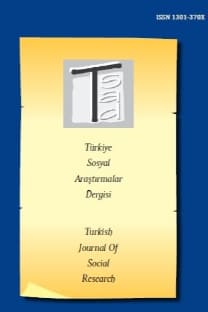Coğrafya Öğretiminde Eleştirel Düşünme Stratejileri ve Sorgulama Yoluyla Öğrenmenin Kullanımı
Bu çalışmada, coğrafya derslerini yürütecek olan bir coğrafya öğretmeninin kullanabileceği bazı öğretim stratejileri ele alınmıştır. Çalışmada, coğrafî diyalog ve düşünme becerilerini geliştirme bağlamında sorgulama yoluyla öğrenme teknikleri kullanılmaktadır. Sınıf ortamında sorgulama yoluyla öğrenmenin gerekçesi açıklanmakta olup, öğrencilerin coğrafî düşünme becerilerini geliştirebilmeleri ve içselleştirebilmeleri için aktif katılım ve öğretim stratejilerine cesaretlendirici bir dizi uygulamaya yer verilmektedir.
Using Critical Thinking Strategies and Inquiry Learning in Geography Instruction
This paper will describe strategies to be employed by the geography teachers in conducting geography courses in classes. This article uses the techniques of philosophical inquiry as a means of developing the skills of geographical dialogue and thinking. This also provides a rationale for the role of inquiry in the classroom, a range of practical activities for encouraging students participation and teaching strategies to develop and refine geographical thinking skills.
___
- Açıkgöz, K. (1998). Etkili Öğrenme ve Öğretme. İzmir: Kanyılmaz Matbaası.
- Akpınar, E. (2003). Ortaöğretim Coğrafya Dersleri Yazılı Sınav Sorularının Bilişsel Düzeyleri. Erzincan Eğitim Fakültesi Dergisi Cilt-Sayı: 5(1), 13- 21.
- Amidon, E. and Flanders, A. (1967) The Role of the Teacher in the Classroom, Rev. Ed. Minneapolis: Association for Productive Teaching.
- Ausubel, D.P. (1968) Educational Psychology: A Cognitive View. New York: Holt, Rinehart and Winston.
- Bloom, B.S. ( 1954). “The Thought Process in Discussion” in Sidney J. French (Ed.), Accent on Teaching, New York: Harper&Row. Chap.
- Bloom, B.S. (1964) (ed.) Taxonomy of Educational Objectives, Handbook I: Cognitive Domain ( New York: McKay. David R. Krathwohl et al. (1964)., Taxonomy of Educational Objectives. Handbook II: Affective Domain .New York: McKay.
- Carr, W. and Kemmis, S. (1986). Becoming Critical: Education, Knowledge and Action Research,Lewes: Falmer.
- Chaffee, J. (1994). Thinking Critically. Boston: Houghton Mifflin.
- Crabtree, C. (1967). “Effects of Structuring on the Productiveness of Chıldren’s Thinking,” Journal of Experimental Education, 36, 1-13.
- Coğrafya Dersi Öğretim Programı. (2005). Coğrafya Dersi Öğretim Programı ve Kılavuzu (9-12. sınıflar) Ankara: M.E.B.
- Coombs, J.R. and Meux, M., (1971) “Teaching Strategies for Value Analysis” in Lawrence E. Metcalf (ed.), Values Education, 41st Yearbook of the naional Council for the Social studies Washington, D.C:The Council, Chap.2.
- Dewey, J. (1910). How We Think. Boston: Allyn and Bacon.
- Doğanay, H. (2002), Coğrafya Öğretim Yöntemleri, Erzurum, Aktif Yayınevi, s. 184-185.
- Flanders, N.A. (1965) Teacher Influence, Pupil Attitudes, and Achivement, Cooperative Research Monograph no. 12, U.S.O.E. Washington, D.C.: GPO.
- Huitt, W. (1995). Success in the information age: A Paradigm Shift. Valdosta, GA: Valdosta State.
- Jersild, A.T., (1947). Child Psychology, (3d ed.) Englewood Cliffs, N.J.: Prentice-Hall, pp.218.
- Kneale, P. (2002), Careers for Geography Graduates. Journal of Geography in Higher Education 26, 3, 405 – 412
- McAulay, J. D. ( 1965 ) “Controversial Issues in the Social Studies”, Education, pp. 27-30.
- Kökdemir, D. (1999). Üniversitelerde bir eleştirel düşünme yöntemi. Cumhuriyet Bilim Teknik, 632, 4-5.
- Lark, L.H. and Starr (1991). Secondary and Middle School Teaching Methods. New York: Macmilla Publishing Company.
- Moffett, J. (1968) A Student-Centered Language Arts Curriculum, Grades K-13: A Handbook for Teachers. Boston: Houghton Mifflin.
- Ralph, C. & Wayne, H. (1967). Teaching Social Studies in the Elementary School. New York: Holt Rinehart and Winston Inc.
- Sarpkaya, R. (2005). Sınıfın İlişki Düzenini Oluşturma. H. Kıran (Ed.) Etkili Sınıf Yönetimi. Ankara: Anı Yayıncılık.
- Seferoğlu, S.S. ve Akbıyık, C. (2006). Eleştirel Düşünme ve Öğretimi. H. Ü. Eğitim Fakültesi Dergisi, 30, 193-200.
- Şahinel, S. (2005). Eleştirel Düşünme. Ö. Demirel (Ed.) Eğitimde Yeni Yönelimler.Ankara: Pegem A Yayıncılık.
- Taba, H. et al.,( 1964) Thinking in Elemantary School children, U.S.O.E. Cooperative Research Project 1574, San Francisco State College.
- Taba, H. et al. (1971). A Teacher’s Handbook for Elementary Social Studies: An Inductive Approach. Addison: Reading, Mass.
- Wayne L. Herman, Jr. (1967). The use of Language Arts in Social Studies Lessons. American Educational Research Journal, pp. 117-124.
- ISSN: 1301-370X
- Başlangıç: 2015
- Yayıncı: AKADEMİSYENLER BİRLİĞİ DERNEĞİ
Sayıdaki Diğer Makaleler
Sosyal Bilgiler Ders Kitaplarında Güncel Konular
Ailede Çocuk İstismarı ve İhmali
Mustafa YILDIZ, Hüseyin ÇALIŞKAN
Gerçekçi Olmayan İyimserlik Kuramı
Otellerde Ev İdaresi Yöneticilerin Karşılaştıkları Sorunların İncelenmesi
Coğrafya Öğretiminde Eleştirel Düşünme Stratejileri ve Sorgulama Yoluyla Öğrenmenin Kullanımı
Tüketicinin Korunması Hakkında Kanun Değişikliği ve Yeni Tüketici Haklarının Değerlendirilmesi
